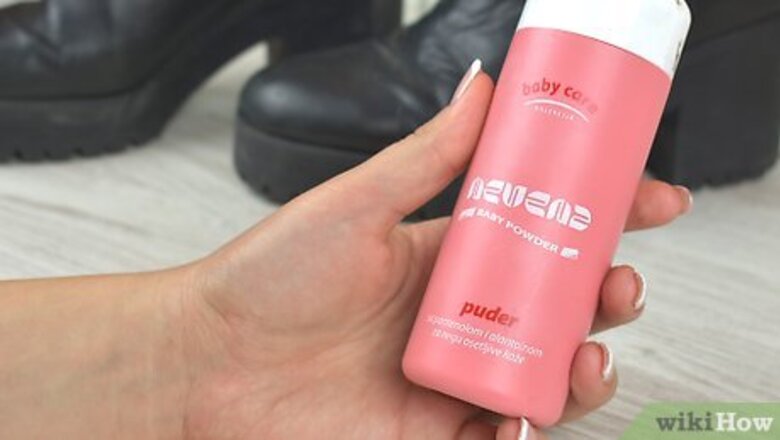
views
Reducing Friction with Talcum Powder
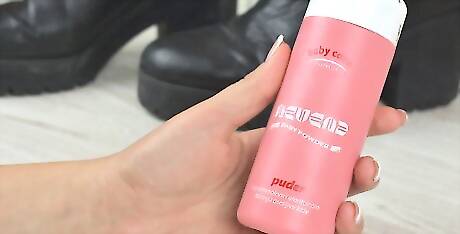
Opt to apply talcum powder to your soles if the squeaking is inside. If you’re walking around in your boots and you hear squeaking come from inside of your boots, the problem is likely caused by the friction between your insoles and rubber bottoms. As you walk, your insoles are rubbing against the rubber underneath, causing the squeaking sound. Talcum powder will create a protective layer between the insole and sole and reduce the squeaking noise. If your shoes are brand new, return them. New boots that squeak are a sign of bad interior gluing, and removing the insole to try and fix them may void your warranty.

Remove the insole from the inside of each boot. The insole refers to the padded layer of fabric that rests at the interior bottom of each boot. Reach inside each of your boots and pry up the insole with the tip of your finger. Once you’ve pried the edge up, pull lightly on each insole to remove them from your boots. If you can’t lift the insoles out, they’re likely glued into the base.Tip: If your insole is glued into the base, you can rip it out if you’d like to and re-glue it later with contact cement. However, squeaking is rarely the insole’s fault if it’s glued in. In addition, you can always leave the insoles unglued—you’ll still be able to comfortably wear your boots.

Apply a layer of talcum powder to the inside of your boot. With the insoles removed, grab a small bottle of talcum powder. Lift each boot up and turn the bottle over to sprinkle roughly 2 tablespoons (50 g) of talcum powder into your boots. Shake each boot back and forth a little to spread the talcum powder around the bottom of each shoe. You can use a thin paper towel, napkin, or coconut oil instead of talcum powder if you prefer. Talcum powder reduces moisture and absorbs odors though, providing an additional benefit for your feet.
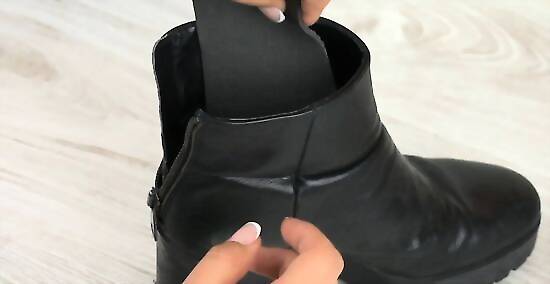
Slide your insole back into the bottom of your shoe. Slide each insole back into their corresponding boot. Press down along the rims of each insole to insert them back into their original positions. Slide your boots on to your feet and walk around for a little to ensure that your insoles are comfortably in place. If you opted to remove insoles that had been glued in, it is better to leave your insoles unglued. You should be able to comfortably wear them without the adhesive keeping the insoles in place.
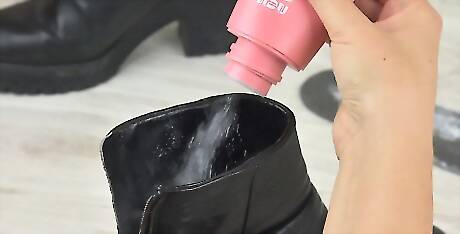
Add more talcum powder whenever you hear your boots squeaking. As moisture breaks down the talcum powder and it starts eroding away into the fibers of the rubber, you may hear the boots start squeaking again. If you do, simply reapply another layer of talcum powder to the bottom of each insole.
Silencing Soles with Dryer Sheets or Sandpaper
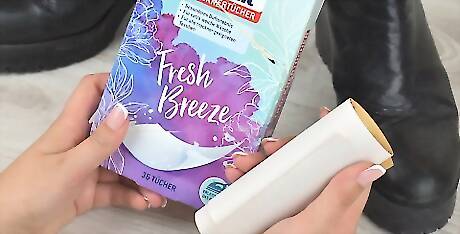
Lubricate or scrape the soles if the squeaking comes from the bottom. If you can hear the squeaking coming from the exterior of your boots and you don’t feel the insoles moving at all, the problem is likely the soles themselves. If you have hard rubber soles, they may squeak when they rub against the floor that you’re walking on. Lubricating or adding a texture to your soles will solve this problem. If your boots squeak when you walk in grass, dirt, or some other soft surface, the problem isn’t the bottom of your soles.

Wipe the bottom of your boots with a damp cloth to remove dirt and grime. Run a clean cloth under warm water and wring it out. Lift each boot up and rub the rubber soles with your cloth to remove most of the dirt or residue on each sole. Wrap the cloth around your finger to get into the grooves between the individual pads on each foot. Your boots don’t need to be spotless for this to work, but you do need to remove any major layers of dirt.
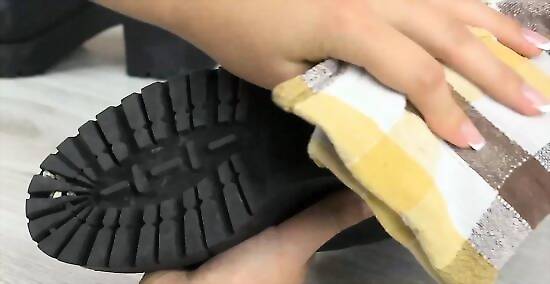
Dry the soles of your shoes with a clean cloth. Rub each sole down with a clean, dry cloth to wipe up most of the dirt. Wrap the cloth around your finger to wipe down the groves. Rub the cloth back and forth across the surface of each sole to absorb the water.Tip: You can also choose to simply let your boots air dry. The boots do need to be totally dry for this method to work, so if you aren’t in a hurry, set them out for 1-2 hours to let them air dry.
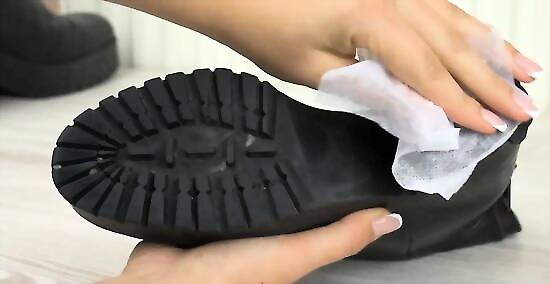
Rub the soles with a dryer sheet to stop general squeaking. If your shoes tend to squeak on any flat surface, grab a dryer sheet. Hold the dryer sheet flat in your hand and firmly rub it against the bottom of the first rubber sole. Rub it back and forth over the surface of the sole to spread the residue over the entire surface. Repeat this process with a new dryer sheet on your other boot. The residue from the dryer sheet will adhere to the bottom of your soles and provide a layer of light lubrication. This will keep your soles from squeaking without creating so much lubrication that you slide all over the place.
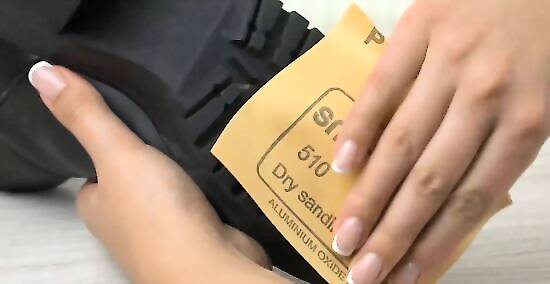
Scrape the soles with fine sandpaper to stop squeaking on slick surfaces. If you notice the squeaking is particularly bad on gym floors or smooth cement, your soles likely aren’t going to benefit much from light lubrication. To create some grip, get a sheet of fine sandpaper with a grit of 60-120. Take the sheet in the palm of your hand and use it to lightly scrape the bottom of your soles. This will create a less uniform grip and prevent squeaking on slick surfaces. Adding some grooves into the rubber soles will prevent squeaking without lubricating your shoes. You will have to physically modify your shoes though, so you won’t be able to return them after you do this.
Using Saddle Soap
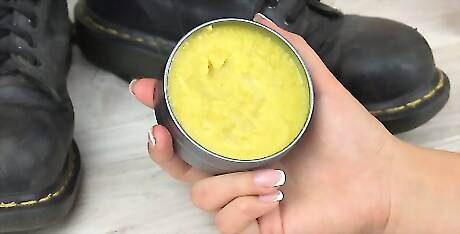
Get a saddle soap if the tongue and laces are squeaking. Saddle soap is a leather lubricant designed to treat horse saddles. If you hear squeaking coming from the tops of your boots, the friction between your tongue and sides is the problem and saddle soap will help. Buy saddle soap from an outdoor goods store or leather repair shop. This is a common issue with newer shoes. If you don’t mind living with the squeaking for a little, it may go away after you’ve worn your boots for a few weeks as the leather starts to soften.

Remove the laces from each of your boots. Untie your laces and pull them out of each boot. Work your way from the top of the tongue to the bottom of the shoe to avoid fraying your laces.Tip: If you’ve worn your boots several times before you’ve decided to apply saddle soap, brush the tongue with a stiff-bristled brush first to get the dust off. Some saddle soaps require water to activate it. If your soap requires water, simply pour a few drops of water into the top of the soap to soften it once you open the top.
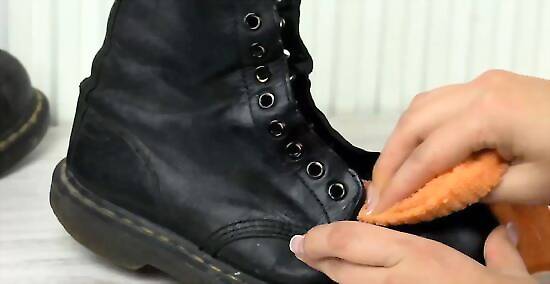
Work the soap into the leather with a microfiber cloth. Dip a clean, microfiber cloth into the soap. Wet the cloth first if your soap requires water to activate it. Use your nondominant hand to brace the backside of the tongue on your first boot. Scrub the tongue with your microfiber cloth using firm, circular strokes. Work up and down the tongue 4-5 times to fully smooth the soap into the leather and lubricate it. Repeat this process on your other boot. You don’t need a ton of saddle soap to lubricate and protect your boots. A quarter-sized dollop of soap per shoe should be perfectly fine. You can use saddle soap on your entire boot if you’d like, but if your only goal is to stop squeaking, it isn’t necessary.
Applying Conditioning Oil
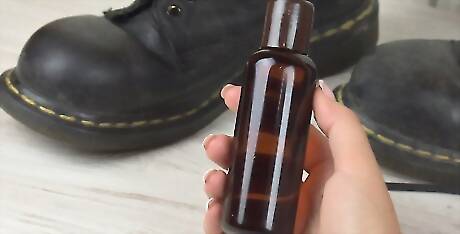
Use conditioning oil if your boot’s leather is just generally squeaky. If your leather seems naturally squeaky and stiff, conditioning oil will soften and protect it while preventing loud squeaking. Get a conditioning oil from an outdoor goods store or a leather supply shop. Conditioning oil is often called leather conditioner or boot oil. All of these products are essentially going to do the same thing though.
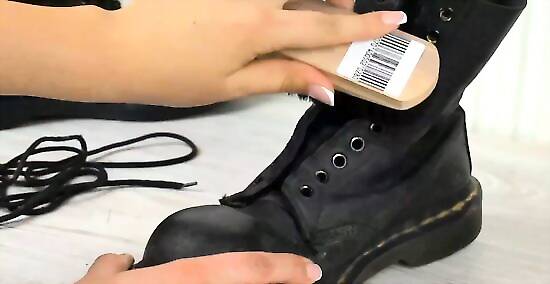
Remove the laces from your boots and brush the leather. Untie the laces on each of your boots. Pull the laces out working your way from the top down. Use a stiff-bristled brush to brush the dust and dirt off of your boots.
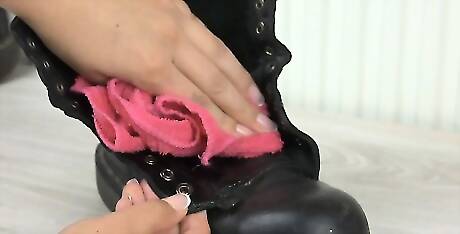
Rub conditioning oil into your boots with a clean cloth. With the laces removed, open the top of your can of conditioning oil. Rub the cloth into the surface of your oil. Brace your first boot by stuffing your nondominant hand into it. Apply the oil into the sides, tongue, and back of the shoes with your cloth. Load your cloth back up with the conditioning oil whenever the cloth starts to dry out. Repeat this process on the other boot to fully lubricate your leather.Tip: Your boots may be oily for a little bit, but the conditioning oil will work its way into the leather as it dries out.




















Comments
0 comment